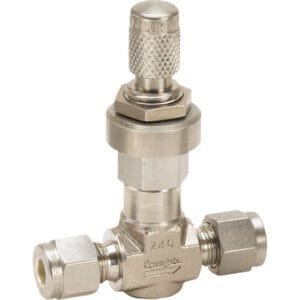KF (QF) HV Blank Flanges (304L SS): High-Performance Sealing for Critical Vacuum System Integrity
KF (QF) HV Blank Flanges (304L SS) are precision-engineered components used to seal off unused ports in high-vacuum (HV) systems, ensuring structural integrity, operational flexibility, and leak-free performance. Manufactured to ISO standards for Klein Flansche (KF) fittings, these blank flanges are essential for vacuum system builders who demand consistent sealing and compatibility across their foreline and chamber components.
Constructed from high-purity 304L stainless steel, KF (QF) HV Blank Flanges (304L SS) offer excellent resistance to high temperatures, mechanical stress, and corrosive environments—making them ideal for challenging laboratory, semiconductor, and industrial vacuum applications. These blank flanges are designed to be used with standard KF flange assemblies, providing a reliable and easily removable sealing option for any unused port.
The sealing mechanism of each KF (QF) HV Blank Flange (304L SS) relies on a rubber or elastomeric o-ring held in place by a centering ring. When mated with another KF flange using a circumferential clamp—secured via wing-nut, thumbscrew, bolt, or over-center lever—the result is a tight, repeatable vacuum seal capable of withstanding pressures down to 10⁻⁸ Torr. The back surface of the blank flange is chamfered to ensure proper alignment and compression of the o-ring during sealing.
The 304L stainless steel used in these KF (QF) HV blank flanges is known for its low carbon content, making it particularly resistant to intergranular corrosion after welding or prolonged exposure to high temperatures. This ensures long-term durability and cleanliness in applications involving chemical vapors, reactive gases, or thermal cycling. It is the material of choice for systems requiring the highest standards of vacuum integrity and reliability.
These KF (QF) HV Blank Flanges (304L SS) are suitable for use in vacuum systems with thermal ranges of 0 °C to 120–180 °C, depending on the o-ring compound. They are frequently installed in vacuum deposition chambers, analytical equipment, cryogenic systems, and high-vacuum research setups where modularity and future port accessibility must be preserved.
Available in standard KF sizes including KF16, KF25, KF40, and KF50, TFM’s blank flanges are machined to tight tolerances to ensure a consistent sealing surface. For advanced applications, we also offer customized versions with features such as vent holes, precision-polished surfaces, or laser-engraved part IDs to support system tracking and validation.
In summary, KF (QF) HV Blank Flanges (304L SS) provide a durable, chemically resistant, and vacuum-compatible method for sealing KF ports in high-performance environments. Their material reliability, easy installation, and ISO-standard compatibility make them a trusted component in both industrial and scientific vacuum systems.
Ordering Table
Accessories Table
| Description | For | Per Package | Part Number |
| Cast Clamps (SS) | KF10, KF16 Flanges | 1 | QF16-075-CS |
| Cast Clamps (SS) | KF25 Flanges | 1 | QF25-100-CS |
| Cast Clamps (SS) | KF40 Flanges | 1 | QF40-150-CS |
| Cast Clamps (SS) | KF50 Flanges | 1 | QF50-200-CS |
| Cast Clamps (Aluminum) | KF10, KF16 Flanges | 1 | QF16-075-C |
| Cast Clamps (Aluminum) | KF25 Flanges | 1 | QF25-100-C |
| Cast Clamps (Aluminum) | KF40 Flanges | 1 | QF40-150-C |
| Cast Clamps (Aluminum) | KF50 Flanges | 1 | QF50-200-C |
| Lever Clamps (Aluminum) | KF10, KF16 Flanges | 1 | QF16-075-CHA |
| Lever Clamps (Aluminum) | KF25 Flanges | 1 | QF25-100-CHA |
| Lever Clamps (Aluminum) | KF40 Flanges | 1 | QF40-150-CHA |
| Centering Ring (SS with Fluorocarbon O-Ring) | KF10 Flanges | 1 | QF10-050-SRV |
| Centering Ring (SS with Fluorocarbon O-Ring) | KF16 Flanges | 1 | QF16-075-SRV |
| Centering Ring (SS with Fluorocarbon O-Ring) | KF25 Flanges | 1 | QF25-100-SRV |
| Centering Ring (SS with Fluorocarbon O-Ring) | KF40 Flanges | 1 | QF40-150-SRV |
| Centering Ring (SS with Fluorocarbon O-Ring) | KF50 Flanges | 1 | QF50-200-SRV |





Reviews
There are no reviews yet.